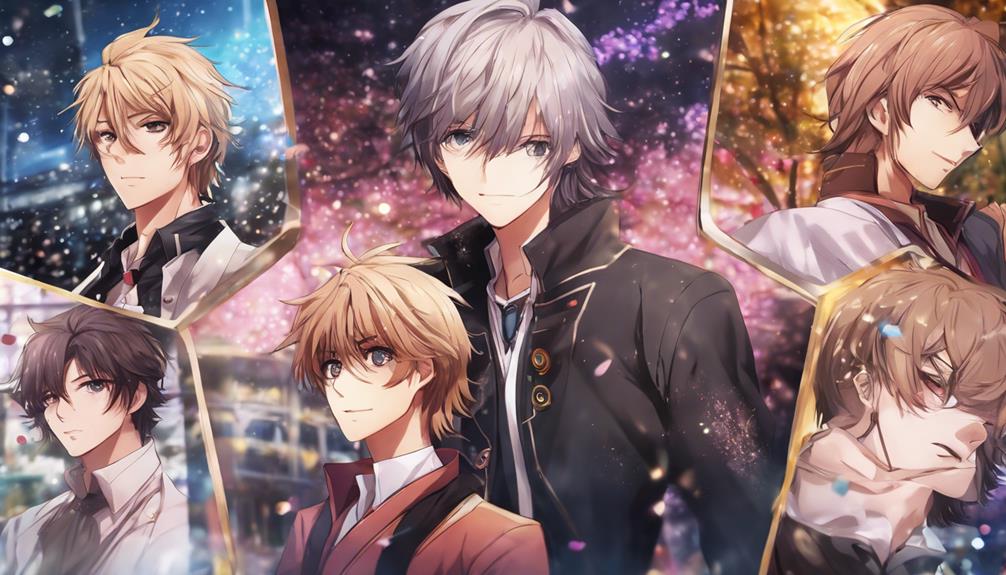Begin an exhilarating journey into the domain of otome games, where immersive storytelling and romantic pursuits await female players. Originating in Japan, otome games focus on intricate relationships with male characters, blending visual novels with simulation elements. Diverse character archetypes and enthralling narratives draw a global audience, enhanced by stunning art and aesthetics. While controversies exist, the genre evolves with inclusive options and VR innovations. Delve deeper into the enchanting world of otome games to uncover the exciting trends shaping their future and the vibrant fan culture surrounding them. Discover the intricacies of otome gaming beyond its surface appeal.
Key Takeaways
- Otome games are interactive romance stories for female players.
- They focus on developing relationships with male characters.
- Player choices shape the narrative and multiple endings.
- Diverse character archetypes and art styles enrich the experience.
- Otome games offer immersive romantic narratives with simulation elements.
Otome Games: Definition and Origins
Otome games have emerged as interactive storytelling experiences primarily designed for female players, emphasizing the development of romantic relationships between a female protagonist and male characters. Originating in Japan, these games, known for their diverse themes and character archetypes, have gained popularity globally. The term 'otome,' meaning 'maiden' or 'young lady' in Japanese, perfectly encapsulates the target audience and romantic focus of these games.
These unique games blend elements of visual novels and simulation games, offering players the opportunity to make choices that influence the storyline and romantic outcomes. Otome games cater to a wide range of interests, providing engaging narratives, diverse love interests, and interactive gameplay for players to immerse themselves in. With their emphasis on romance and storytelling, otome games stand out in the gaming world, offering a different experience compared to other genres. The origins of otome games have paved the way for a genre that continues to evolve and captivate players worldwide.
Otome Vs. Other Game Genres

When comparing otome games to other genres, it's crucial to understand their unique features, like the focus on developing romantic relationships with male characters.
By examining gameplay styles, we can see how otome games stand out within the adventure game category.
The appeal of otome games lies in their ability to cater to a specific target audience of women interested in immersive storytelling and romantic narratives.
Otome Uniqueness Explained
In comparison to other game genres, Otome games distinguish themselves by centering on developing romantic relationships and emotional connections with male characters, offering players a more personalized and engaging experience.
- Otome games are tailored for a female audience, providing a unique perspective on character interactions and storytelling.
- The genre combines elements of visual novels and simulation games to create interactive narratives with branching storylines.
- Players can explore diverse character archetypes, themes, and settings, catering to various interests and preferences within the romantic genre.
Comparing Gameplay Styles
Comparing gameplay styles between Otome games and other genres reveals distinctive focuses on narrative-driven romance and character interactions, setting them apart in the gaming landscape. Otome games prioritize developing romantic relationships with male characters through player choices, creating a story-driven experience centered around character development and relationships.
In contrast, other genres may emphasize different objectives such as action, strategy, or broader themes, catering to varied demographics. While otome games target a mainly female audience, they stand out for their unique gameplay style that prioritizes narrative, romance, and player decisions for relationship progression.
This distinct approach separates otome games from genres like action, RPGs, or shooters, where gameplay mechanics and objectives diverge significantly from the character-driven focus of otome games.
Appeal to Target Audience
The unique appeal of otome games to their target audience stems from their focus on romance, character interactions, and the player's agency in shaping the narrative.
Otome games are crafted for a female audience, emphasizing romantic relationships between the protagonist and male characters.
Unlike other genres, otome games prioritize storytelling and character development over action-packed gameplay.
Players are drawn to otome games for their diverse character archetypes, engaging narratives, and the ability to make choices that influence the story's outcome.
These elements combine to create immersive experiences centered around love, relationships, and emotional connections, catering to players seeking deep and meaningful interactions in their gaming experiences.
Otome Game Elements Breakdown

Exploring the intricate components of otome games, we investigate the breakdown of their unique game elements. Otome games blend visual novels with simulation game aspects to create interactive storytelling experiences.
In these games, player choices are essential, shaping romantic routes and determining multiple endings. Players can also personalize the main character's appearance and influence the story's progression through their decisions.
Some otome games incorporate elements where players can enhance character-specific traits by engaging in activities to raise stats. Additionally, otome games offer different gameplay styles, such as route-based and free-for-all, which are influenced by the choices players make throughout the game.
Understanding these elements is vital for mastering otome games and immersing oneself in the enthralling narratives they offer. Players must also pay close attention to character dynamics and subtle visual cues, such as changes in facial expressions or body language, to fully grasp the emotional depth of each interaction. One particularly unique feature in some otome games is the use of “cat pupil language,” where the size and shape of a character’s pupils can hint at their underlying emotions or intentions. This attention to detail enriches the overall experience, allowing players to connect more deeply with the narrative and characters.
Otome Art and Aesthetics

Immersing players in enchanting visual worlds, otome game art showcases exquisite character designs and immersive backgrounds that set the stage for romantic narratives. When exploring otome art and aesthetics, one can appreciate the following key aspects:
- Artistic Styles: Otome games offer a diverse range of artistic styles, from anime-inspired designs to realistic illustrations, catering to a wide spectrum of visual preferences.
- Background Art: The background art in otome games plays an essential role in creating immersive environments that enhance the storytelling experience, setting the tone for romantic encounters and plot development.
- CGs: CGs, or Computer Graphics, in otome games capture pivotal romantic moments between the protagonist and their love interests with remarkable detail, adding emotional depth to key scenes.
These elements combine to create a visually alluring experience for players, drawing them into the enchanting worlds of otome games and enriching the overall narrative journey.
Otome Demographics and Appeal

Exploring the realm of otome games reveals a mesmerizing world tailored for a predominantly female audience, featuring romantic narratives intertwined with interactive gameplay. The allure of otome games lies in their ability to cater to the interests of a female audience by presenting intriguing romantic storylines with male characters. These games offer a diverse range of character archetypes, from the brooding bad boy to the charming prince, allowing players to delve into various romantic scenarios and interactions within the game world.
The attraction of otome games extends beyond gender boundaries, drawing in players globally who are captivated by the engaging narratives and interactive elements that these games offer. As the genre evolves, Western-produced otome games introduce unique themes and gameplay mechanics, further broadening the appeal of these romantic adventures. Whether players seek heart-fluttering romance or immersive storytelling, otome games continue to enchant a wide range of audiences with their immersive and enchanting experiences.
Otome Localization and Global Impact

Moving from the discussion on Otome Demographics and Appeal, the localization of otome games and their global impact have greatly expanded the genre's reach and popularity.
- Localization Efforts: Otome games have been successfully localized from Japanese to English and other languages, involving tasks like translating text, adapting cultural references, and adjusting gameplay elements for international players.
- Official English Releases: Many otome games now receive official English releases, which not only make them more accessible to a wider audience but also contribute to the global popularity of the genre.
- Increased Accessibility: The global impact of otome games has led to increased accessibility and popularity outside of Japan, allowing players worldwide to enjoy these romantic visual novels.
Through these localization efforts and official English releases, otome games have found a loyal fanbase beyond their country of origin, contributing to the genre's growth and recognition on a global scale.
Otome Community and Fan Culture

Engaging with a vibrant online presence, otome communities foster connections among enthusiasts through dedicated forums, social media groups, and fan events. These spaces provide a platform for fans to share their love for otome games, discuss plotlines, characters, and partake in various fan activities like creating fan art, fan fiction, and cosplay. Fan engagement is vital in these communities, with enthusiasts actively participating in discussions and sharing their gameplay experiences. Some otome game developers also interact with their fan base through social media, polls, and surveys, seeking feedback to enhance future game releases. Additionally, fan translators play an important role in the otome community by translating Japanese otome games into English, making them more accessible to a broader audience.
| Otome Community & Fan Culture | |
|---|---|
| Dedicated Forums | Social Media Groups |
| Fan Events | Fan Art, Fan Fiction, Cosplay |
| Online Platforms (Tumblr, Discord, Twitter) | Developer-Fan Interactions |
| Fan Translators | Gameplay Experiences, Feedback |
Otome Challenges and Controversies

In the world of otome games, challenges and controversies often highlight the complexities of maneuvering sensitive themes and relationships within the narrative. Representation, toxic relationships, and consent stand out as key points of contention within the otome gaming community.
Some otome games have faced criticism for perpetuating unhealthy relationship dynamics, sparking debates about the portrayal of toxic relationships.
Controversies in otome games often revolve around issues of consent, raising questions about how relationships are depicted and developed.
The representation of toxic relationships in otome games has prompted discussions among players and developers, emphasizing the importance of portraying healthy relationship dynamics.
Navigating these challenges and controversies requires a delicate balance between storytelling and addressing player concerns. As the otome genre continues to evolve, addressing these sensitive topics in a thoughtful and responsible manner remains essential for the community's growth and development.
Otome Future Trends and Innovations

As otome games evolve, we see exciting advancements in the incorporation of virtual reality experiences, augmented reality features, and interactive storytelling elements. These technological innovations are reshaping the otome genre, offering players more immersive and engaging gaming experiences.
Additionally, collaborations with industries like fashion, music, and entertainment are enriching otome games, paving the way for unique and diverse narratives.
Otome Genre Evolution
Evolving to meet the demands of a diverse audience, the otome genre is embracing innovative features and inclusive storytelling elements.
- Diverse character archetypes: From brooding bad boys to charming princes, otome games now offer a wide range of character options for players to interact with.
- Interactive player choices: Players can now make decisions that greatly impact the storyline, adding a layer of depth and personalization to the gaming experience.
- Inclusive romance options: The genre is moving towards more LGBTQ+ representation, allowing for a broader spectrum of romantic relationships to be explored.
These advancements in the otome genre are revolutionizing the way stories are told and experienced, catering to a growing audience seeking diverse narratives and engaging gameplay.
Technological Advancements
Exploring cutting-edge technologies, otome games are revolutionizing player experiences with immersive VR integration and dynamic AI interactions. VR integration allows players to immerse themselves in enchanting virtual worlds, enhancing the overall gaming experience.
AI technology further enhances gameplay by creating dynamic and personalized interactions with characters, making each playthrough unique. Augmented reality features are also being explored to add another layer of engagement and excitement to otome games.
Additionally, the introduction of online multiplayer options enables players to interact with each other in virtual worlds, fostering a sense of community and connection. Cross-platform compatibility guarantees that players can enjoy their favorite otome titles seamlessly across various devices, catering to the evolving needs of the gaming community.
Otome Recommendations for Beginners

For newcomers interested in exploring the world of otome games, here are some recommended titles to help you get started.
- Hakuoki: Immerse yourself in the popular historical supernatural romance otome game series for an engaging experience.
- Backstage Pass: Try this stat-based life simulator romance OELVN, perfect for beginners looking for a compelling storyline.
- Liar- Uncover the Truth: Explore the mystery and puzzle elements of this mobile otome game, ideal for those new to the genre.
These recommendations cater to beginners by offering diverse storylines and gameplay mechanics, ensuring an enjoyable introduction to the world of otome games. Whether you're interested in historical romance, life simulation, or mystery, these titles provide a range of options to suit your preferences. Western-produced otome games also offer unique narratives and character interactions, making them accessible and exciting for newcomers seeking to explore the genre further.
Frequently Asked Questions
What Does Otome Stand For?
Otome stands for 'maiden' or 'young lady' in Japanese. It refers to games targeted towards a female audience where players pursue romantic relationships.
The genre features a female protagonist pursuing love interests. Originating in Japan, otome games have gained popularity worldwide.
What Is Otome Dating?
Otome dating is the process in otome games where players engage in forming romantic connections with male characters. Through making choices, players influence these relationships, shaping the outcomes and storylines of the game.
The focus is on building emotional bonds and exploring romantic narratives. This gameplay element is vital for character development and narrative progression in otome games. It's an interactive way to experience romantic storytelling and connection-building in a virtual world.
What Is the Meaning of Otome Games?
Otome games are interactive story-based games designed for women, focusing on developing romantic relationships between a female protagonist and male characters. These games, originally popular in Japan, now have a growing Western fanbase.
Otome games offer diverse topics and character archetypes to cater to various interests, available on mobile, PC, and major consoles. Players immerse themselves in engaging narratives while managing romantic pursuits, making otome games a unique and enthralling gaming experience.
What Counts as Otome?
When considering what counts as otome, one must focus on the core elements that define these games. Otome games typically involve female protagonists engaging in romantic relationships with male characters through decision-making.
These games often incorporate visual novel and simulation game features, allowing players to shape the storyline and experience different romantic routes and endings. The genre's emphasis on romance and female lead characters distinguishes otome games in the gaming landscape.
Conclusion
To sum up, otome games are a captivating universe of romance and adventure waiting to be explored.
Just like unraveling a mysterious treasure chest, delving into the world of otome games can open up a whole new domain of storytelling and creativity.
So why not take a chance and immerse yourself in the enchanting world of otome games today?
Who knows, you might just find your next favorite game waiting for you to discover its secrets.











